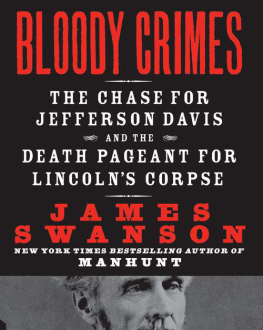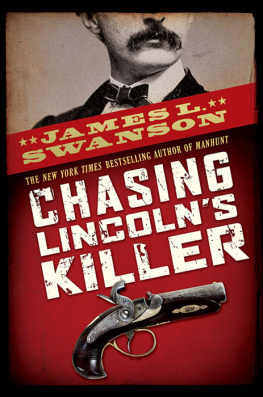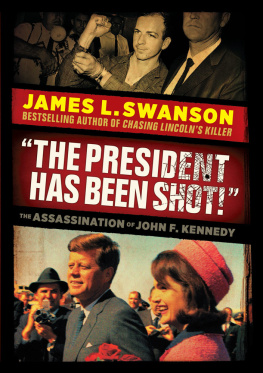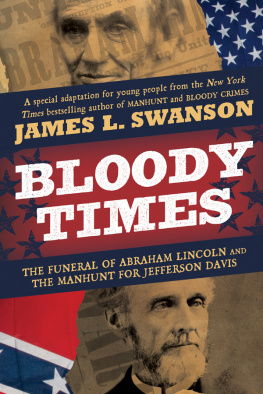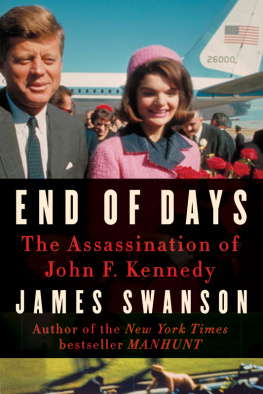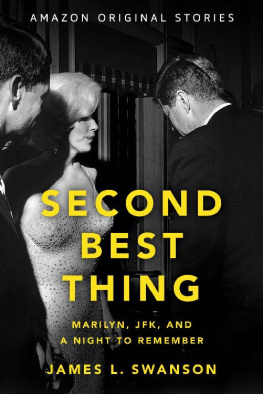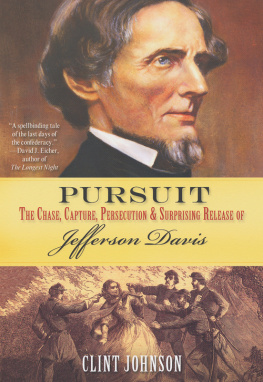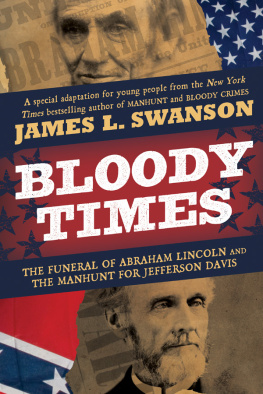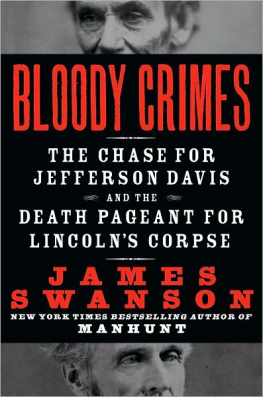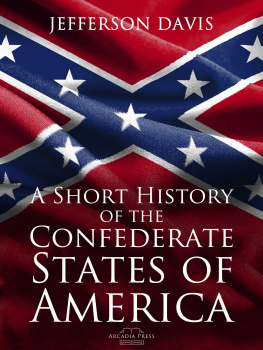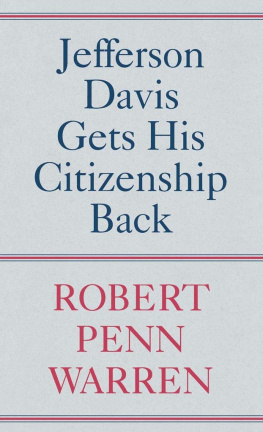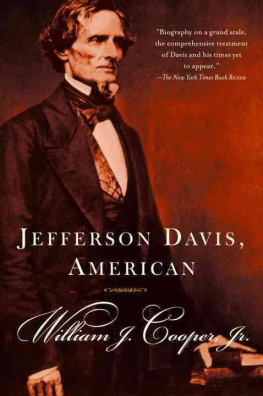In memory of my mother, Dianne M. Swanson (19312008), who looked forward to this book but had no chance to read it.
In remembrance of John Hope Franklin (19152009), with gratitude for three decades of teaching, counsel, and friendship, and with fond memories of University of Chicago days.
| 1. | Bloody Crimes carte de visite of Columbia and her eagle | xiii |
| 2. | Senator Jefferson Davis on the eve of the Civil War | 4 |
| 3. | Fall of Richmond paper flag | 35 |
| 4. | Currier & Ives print of Richmond in flames | 40 |
| 5. | Abraham Lincoln oil portrait, as he appeared in 1865 | 43 |
| 6. | The Petersen House | 104 |
| 7. | Sketch of Lincoln on his deathbed | 112 |
| 8. | The empty bed, just after Lincoln died | 128 |
| 9. | Bloody pillow | 129 |
| 10. | The President Is Dead broadside | 132 |
| 11. | Diagram of the bullets path through Lincolns brain | 134 |
| 12. | The bullet that killed Lincoln | 135 |
| 13. | Allegorical print of Booth trapped inside the bullet | 137 |
| 14. | Portrait engraving of George Harrington | 142 |
| 15. | Invitation to Lincolns funeral | 187 |
| 16. | Post Office Department silk ribbon, April 19 funeral | 190 |
| 17. | Lincolns hearse, Washington, D.C. | 191 |
| 18. | Photograph of General E. D. Townsend | 203 |
| 19. | War Department pass for Lincoln funeral train | 207 |
| 20. | Lincolns funeral car | 211 |
| 21. | Silk mourning ribbon of the U.S. Military Railroad | 213 |
| 22. | President Lincolns hearse, Philadelphia | 221 |
| 23. | The New York funeral procession | 226 |
| 24. | Lincoln in coffin, New York City | 230 |
| 25. | Memorial arch, Sing Sing, New York | 233 |
| 26. | Viewing pavilion, Cleveland, Ohio | 253 |
| 27. | Terre Haute & Richmond Railroad timetable | 260 |
| 28. | Photograph of memorial arch, Chicago | 264 |
| 29. | Lincolns old law office; Springfield, May, 1865 | 272 |
| 30. | A map of the Abraham Lincoln funeral train route | 275 |
| 31. | Harpers Weekly woodcut of burial in Springfield, Illinois | 283 |
| 32. | The first reward poster for Jefferson Davis | 297 |
| 33. | A map of Jefferson Daviss escape route | 300 |
| 34. | Photograph of Davis in the suit he wore at capture | 310 |
| 35. | $360,000 reward poster for Davis | 319 |
| 36. | Three caricatures depicting Davis in a dress | 323 |
| 37. | The raglan, shawl, and spurs Davis wore on the day of capture | 328 |
| 38. | Print of Davis ridiculed in prison | 334 |
| 39. | Sketch of Davis in his cell | 335 |
| 40. | Lincolns home draped in bunting, May 24, 1865 | 339 |
| 41. | Davis as a caged hyena wearing a ladies bonnet | 343 |
| 42. | The True Story print ridiculing Davis | 346 |
| 43. | Oil portrait of Jefferson Davis, ca. 1870s | 360 |
| 44. | Davis and family on their porch at Beauvoir, Mississippi | 362 |
| 45. | Oscar Wildeinscribed photograph | 364 |
| 46. | Jefferson Davis late in life at Beauvoir | 377 |
| 47. | Davis lying in state, New Orleans, 1889 | 379 |
| 48. | A map of the Davis funeral train route | 380 |
| 49. | Daviss New Orleans funeral procession, 1889 | 384 |
| 50. | Raleigh, North Carolina, floral display and procession, 1893 | 385 |
| 51. | The ghosts of Willie and Abraham haunting Mary Lincoln | 389 |
| 52. | Photographs of porcelain Lincoln memorial obelisk | 395 |
| 53. | The site of Jefferson Daviss capture, near Irwinville, Georgia | 399 |
| 54. | Jefferson Daviss library at Beauvoir, Mississippi | 403 |
M y book Manhunt: The 12-Day Chase for Lincolns Killer told the story of John Wilkes Booths incredible escape from the scene of his great crime at Fords Theatre and his run to ambush, death, and infamy at a Virginia tobacco barn. But the chase for Lincolns killer was not the only thrilling journey under way as the Civil War drew to a close in April 1865. While the hunt for Lincolns murderer transfixed the nation, two other men embarked on their own, no less dramatic, final journeys. One, Jefferson Davis, president of the Confederate States of America, was on the run, desperate to save his family, his country, and his cause. The other, Abraham Lincoln, the recently assassinated president of the United States, was bound for a different destination: home, the grave, and everlasting glory.
The title of this book has three originsas a prophecy, a promise, and an elegy.
In October 1859, abolitionist John Brown launched his doomed raid on the U.S. arsenal at Harpers Ferry, Virginia, as a way of inciting a slave uprising. This daring but foolhardy attack, viewed as an affront to the institution of slavery, enraged the South and brought the United States closer to irrepressible conflict and civil war. Following his capture, Brown was tried and sentenced to hang. While in a Charles Town jail awaiting execution, he was allowed to keep a copy of the King James Bible. As the clock ticked down to his hanging, Brown leafed through the sacred text, searching for divinely inspired words of justification, prophecy, and warning. He dog-eared the pages most dear to him and then highlighted key passages with pen and pencil marks, including this verse from Ezekiel 7:23: Make a chain: for the land is full of bloody crimes, and the city is full of violence. On the morning he was hanged, on December 2, 1859, he handed to one of his jailers the last note he would ever write: I, John Brown, am now quite certain that the crimes of this guilty land will never be purged away but with blood.
On March 4, 1865, Abraham Lincoln delivered his second inaugural address. Although remembered today for its message of peacewith malice toward none, with charity for allthe speech had a dark side. In a passage often overlooked, Lincoln warned that slavery was a bloody crime that might not be expunged without the shedding of more blood: Fondly do we hopefervently do we praythat this mighty scourge of war may speedily pass away. Yet, if God wills that it continue, until all the wealth piled by the bond-mans two hundred and fifty years of unrequited toil shall be sunk, and until every drop of blood drawn with the lash, shall be paid by another drawn with the sword, as was said three thousand years ago, so still it must be said the judgments of the Lord, are true and righteous altogether.
Within days of Lincolns assassination on April 14, 1865, a Boston photographer published a fantastical carte de visite image to honor the fallen president. That was not unusual; printers, photographers, and stationers across the country produced hundreds of thousands, if not millions, of ribbons, badges, broadsides, poems, and photographs to mourn Lincoln. But the image from Boston was different, for it expressed a sentiment not of mourning but of vengeance. In
Next page
